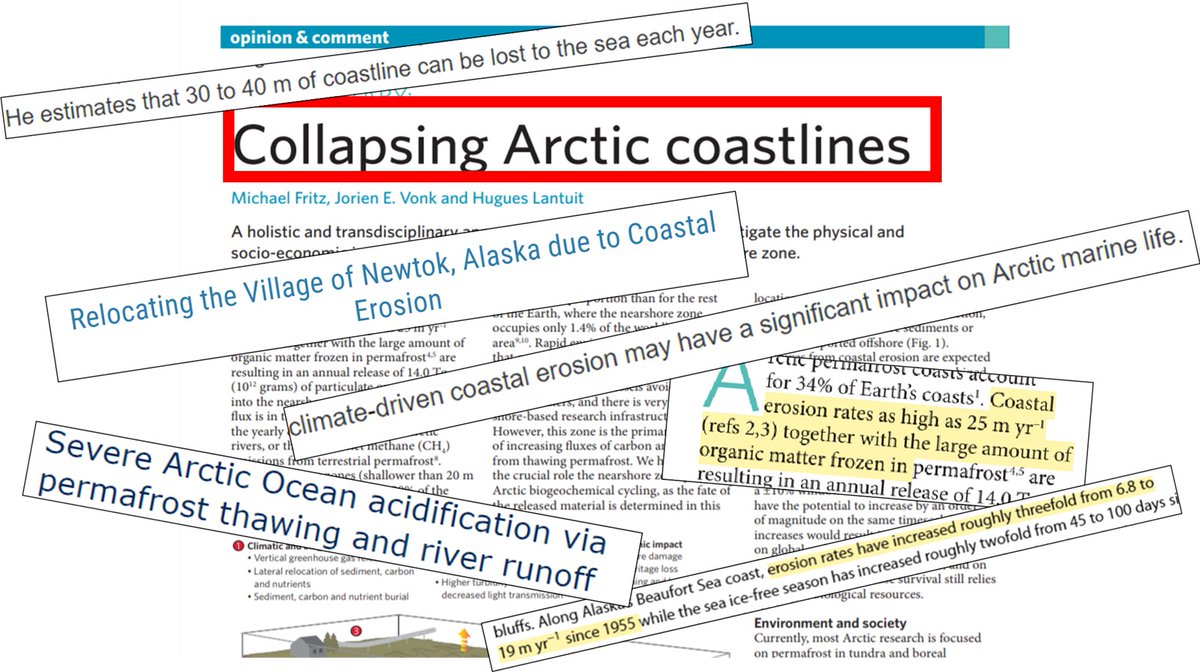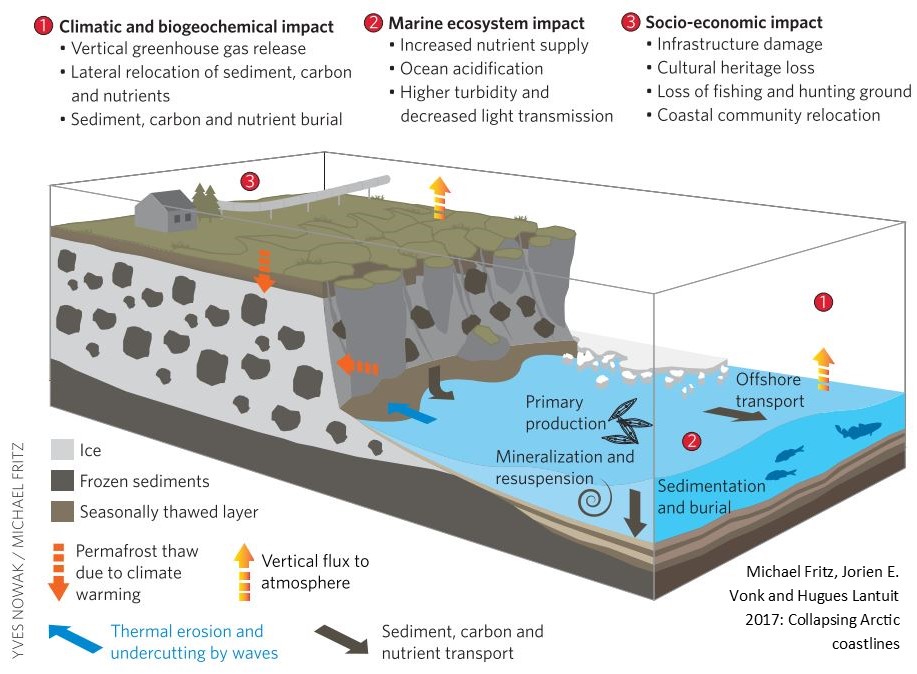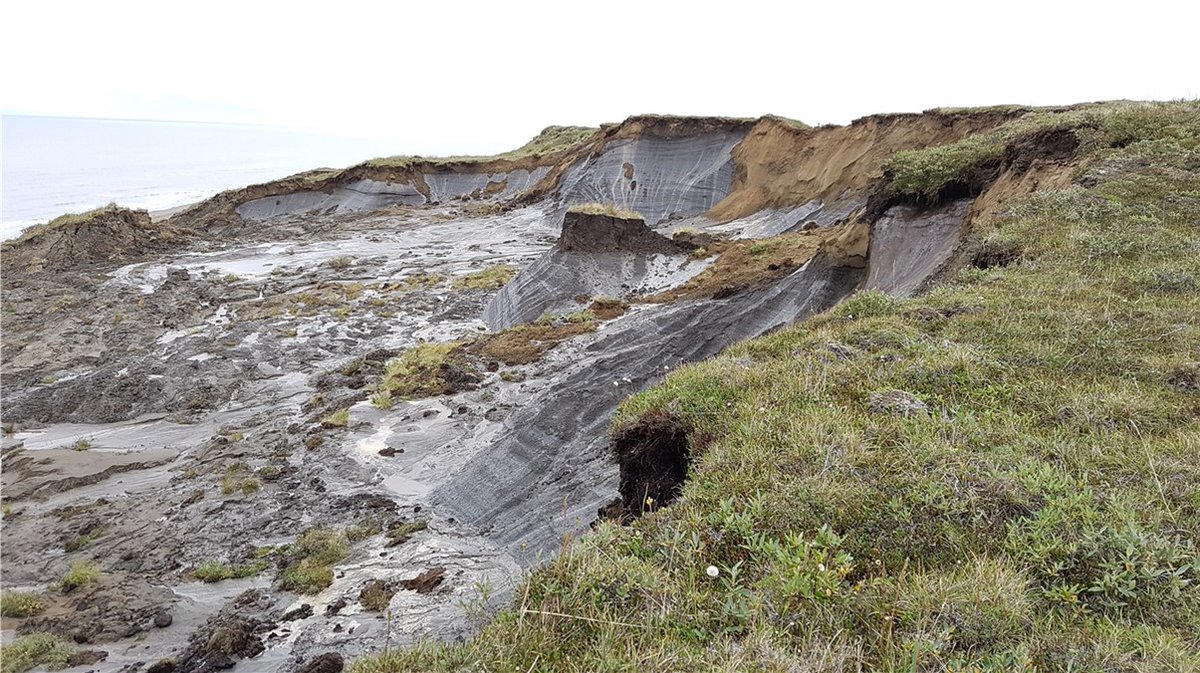
Permafrost is a big topic in climate science. The release of methane, the damage to infrastructure & the massive Siberian craters often make the news. But there’s one area that’s mentioned far less often but is also of huge importance – that is Arctic coastal erosion. Thread 1/17 

In the last few decades, some parts of the Arctic Ocean coastline have undergone massive accelerations in their retreat rates and mass loss. It’s bad enough that it’s even been described as a state of collapse! 2/17 

So, why are these coasts collapsing? There are several important factors behind this, but a key feature to consider are the materials that make up the unconsolidated coasts (the coasts that consist of frozen soil rather than solid rocks). 3/17 

Many of the coasts consist of loose soils bound together and strengthened with ice. But, if conditions are such that the ice in these soils begins to melt, then they become highly vulnerable to erosion and the permafrost can begin to thaw. 4/17 

Thawing is happening, thanks to the rapid warming in the #Arctic. #Seaice cover, which normally protects the coasts, is disappearing. This means more time for the sea to heat up, bigger waves & swells & for longer periods throughout the year. 5/17
https://twitter.com/i_ameztoy/status/1216690937981755397
There is also the top-down warming from the atmosphere, meaning the top part of the permafrost that thaws each summer is growing deeper. There’s extra intense rainfall too, which adds further heat to the permafrost, forest fires, etc. 6/17
https://twitter.com/queenofpeat/status/1310653437814677504
Turning back to the coastal erosion itself, two particular processes, unique to permafrost environments, are often present in some of the fastest eroding coasts:
A - block collapse and
B - retrogressive thaw slumping
7/15
A - block collapse and
B - retrogressive thaw slumping
7/15
Block collapse occurs as waves hit the base of a cliff, causing it to thaw and breaking the soil apart through wave action. This forms a notch that eventually extends into the cliff base, causing the overhanging block to collapse. 8/17
Individual storm events can cause many meters of erosion, with sites such as Pelly Island near the Mackenzie delta, seeing up to 40 m of erosion in a single summer. 9/17
cbc.ca/news2/interact…
cbc.ca/news2/interact…
Some regions, such as along the Teshekpuk Lake Special Area in Alaska has seen retreat rates triple since the mid-20th century. 10/17
link.springer.com/article/10.100…
link.springer.com/article/10.100…

Retrogressive thaw slumps (RTSs) are a form of landslide that occurs in areas where thick layers of ice are present within the permafrost. When exposed to surface energy fluxes, the ice front melts and retreats inland, with the soil on top crumbling… 11/17 

… down into the melt water, forming huge muddy flows that can extend into the sea temporarily as fan shaped deposits. These can transfer huge volumes of material, causing a loss of mass that has a complex and time-varying relationship to shoreline retreat. 12/17
On Banks Island, the number of RTSs increased from 63 in 1984 to more the 4500 in 2015 (go.nature.com/3dOn2Hc), and another study says RTSs are now the dominant form of geomorphic change in the western Canadian Arctic (bit.ly/3tYcH1i). 13/17
The "collapse" of the Arctic coastline appears to be in progress. It is also important for many reasons. Permafrost contains vast stores of carbon, and release of this through coastal erosion could have serious implications for the global carbon budget. 14/17
Locally, the additional carbon input is accelerating ocean acidification (doi.org/10.1038/ngeo26…) & may turn some #Arctic seas into carbon emitters. Also, extra nutrient and pollutants have the potential to seriously disrupt the coastal food web (doi.org/10.1038/nclima…) 15/17
Many villages are having to be relocated or are under threat, local cultural & heritage sites are being lost & a lot of infrastructure is being damaged. With continued #seaice loss & #Arctic amplification, these effects are expected to grow. 16/17
doi.org/10.14430/arcti…
doi.org/10.14430/arcti…
If you've gotten this far, thanks for reading! If sources for anything not included here are wanted, just ask and I'll post them as soon as I can. 17/17
@FECoasts @climatemessages @Permafrostee
@JKSteinberger @ClimateBen @XRebellionUK @SteB777 @CarbonBrief @Paul_Rose @GretaThunberg
Might be of interest?
@JKSteinberger @ClimateBen @XRebellionUK @SteB777 @CarbonBrief @Paul_Rose @GretaThunberg
Might be of interest?
• • •
Missing some Tweet in this thread? You can try to
force a refresh


